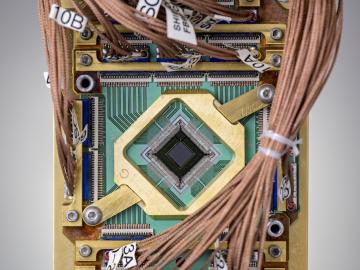
Filter News
Area of Research
- (-) National Security (19)
- (-) Supercomputing (92)
- Advanced Manufacturing (11)
- Biology and Environment (112)
- Biology and Soft Matter (1)
- Building Technologies (2)
- Computational Biology (1)
- Computational Engineering (2)
- Computer Science (8)
- Electricity and Smart Grid (1)
- Energy Science (178)
- Energy Sciences (1)
- Functional Materials for Energy (1)
- Fusion and Fission (10)
- Fusion Energy (3)
- Isotope Development and Production (1)
- Isotopes (5)
- Materials (121)
- Materials Characterization (1)
- Materials for Computing (19)
- Materials Under Extremes (1)
- Mathematics (1)
- Neutron Science (128)
- Nuclear Science and Technology (13)
- Quantum information Science (1)
- Transportation Systems (2)
News Topics
- (-) Big Data (25)
- (-) Environment (26)
- (-) Frontier (32)
- (-) Materials Science (17)
- (-) Neutron Science (15)
- (-) Space Exploration (3)
- (-) Transportation (8)
- 3-D Printing/Advanced Manufacturing (7)
- Advanced Reactors (2)
- Artificial Intelligence (46)
- Bioenergy (11)
- Biology (14)
- Biomedical (17)
- Biotechnology (3)
- Buildings (4)
- Chemical Sciences (5)
- Computer Science (105)
- Coronavirus (16)
- Critical Materials (3)
- Cybersecurity (23)
- Energy Storage (9)
- Exascale Computing (26)
- Fusion (2)
- Grid (11)
- High-Performance Computing (45)
- Isotopes (2)
- Machine Learning (24)
- Materials (16)
- Mathematics (2)
- Microscopy (7)
- Molten Salt (1)
- Nanotechnology (11)
- National Security (36)
- Nuclear Energy (8)
- Partnerships (5)
- Physics (9)
- Polymers (2)
- Quantum Computing (20)
- Quantum Science (26)
- Security (15)
- Simulation (16)
- Software (1)
- Summit (43)
Media Contacts

The U.S. Air Force and Oak Ridge National Laboratory launched a new high-performance weather forecasting computer system that will provide a platform for some of the most advanced weather modeling in the world.

A multi-institutional team became the first to generate accurate results from materials science simulations on a quantum computer that can be verified with neutron scattering experiments and other practical techniques.

A new tool from Oak Ridge National Laboratory can help planners, emergency responders and scientists visualize how flood waters will spread for any scenario and terrain.

In the quest for advanced vehicles with higher energy efficiency and ultra-low emissions, ORNL researchers are accelerating a research engine that gives scientists and engineers an unprecedented view inside the atomic-level workings of combustion engines in real time.

Six scientists at the Department of Energy’s Oak Ridge National Laboratory were named Battelle Distinguished Inventors, in recognition of obtaining 14 or more patents during their careers at the lab.

Six ORNL scientists have been elected as fellows to the American Association for the Advancement of Science, or AAAS.

A multi-institutional team, led by a group of investigators at Oak Ridge National Laboratory, has been studying various SARS-CoV-2 protein targets, including the virus’s main protease. The feat has earned the team a finalist nomination for the Association of Computing Machinery, or ACM, Gordon Bell Special Prize for High Performance Computing-Based COVID-19 Research.

There are more than 17 million veterans in the United States, and approximately half rely on the Department of Veterans Affairs for their healthcare.

The combination of bioenergy with carbon capture and storage could cost-effectively sequester hundreds of millions of metric tons per year of carbon dioxide in the United States, making it a competitive solution for carbon management, according to a new analysis by ORNL scientists.

Oak Ridge National Laboratory scientists have discovered a cost-effective way to significantly improve the mechanical performance of common polymer nanocomposite materials.


